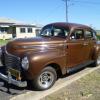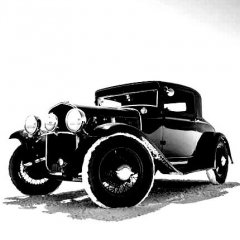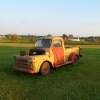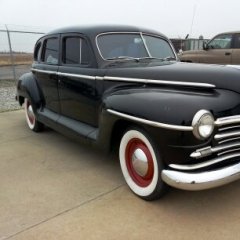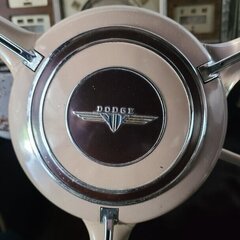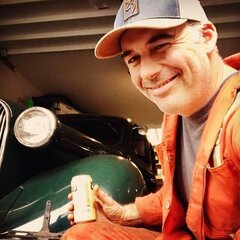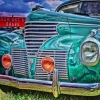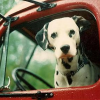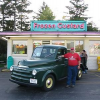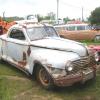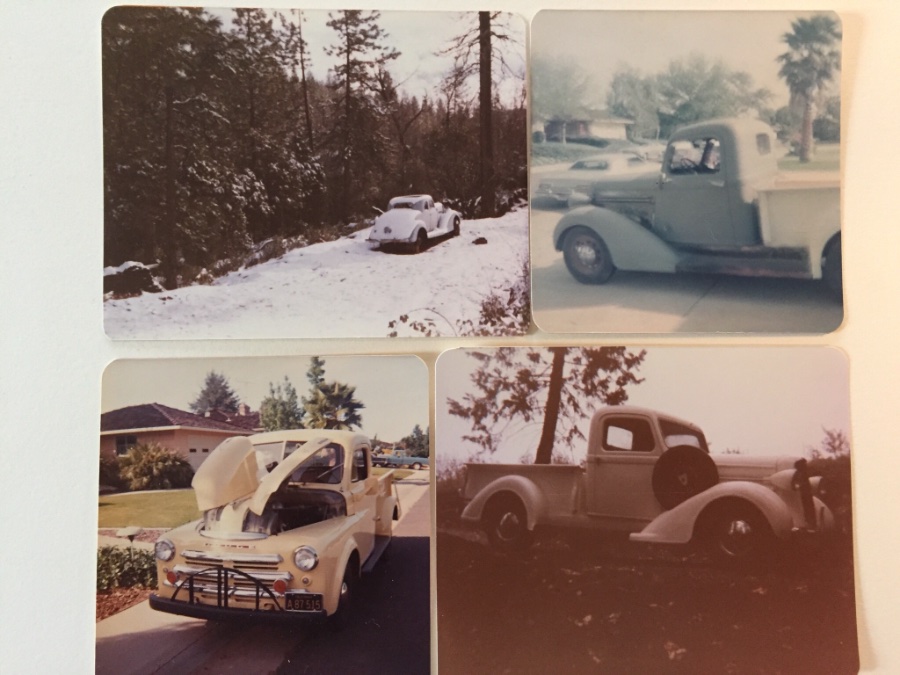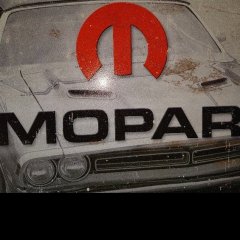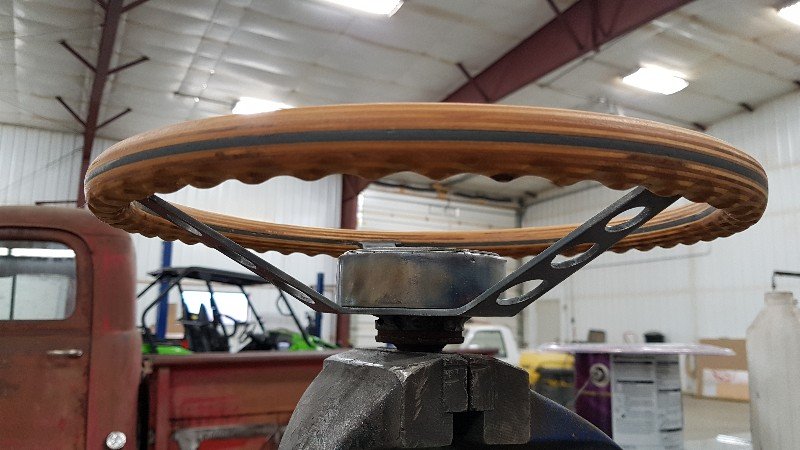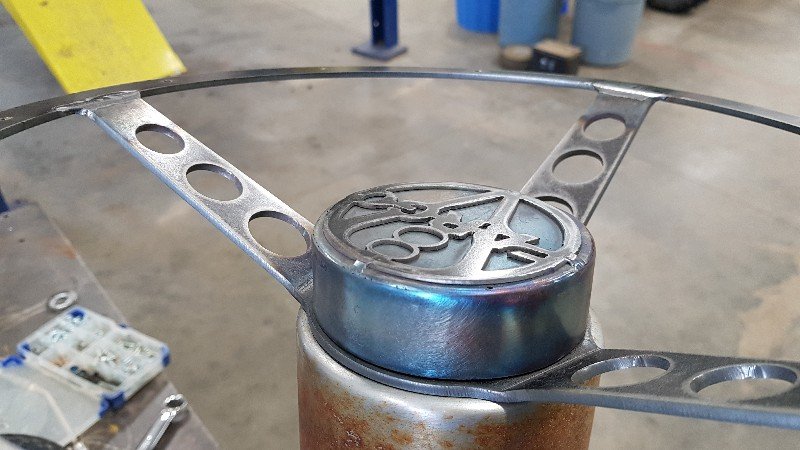Leaderboard
Popular Content
Showing content with the highest reputation on 02/18/2021 in all areas
-
4 points
-
In 1996 I was 14 years old. My dad and I had been talking about finding a 5 window Chevy pickup to restore/modify for my first vehicle. I was always into old iron of all kinds - dad was into antique tractors and just went with it. We had barn/shop space and I was already doing most of the upkeep mechanical work on the farm equipment, antique tractors included. Anyway - one day we went to an estate auction where the individual had owned several John Deere dealerships. Tons of parts and literature from decades ended up his farm and that was really why we were there. Sitting in "junk row" in the fence line of the farm was dozens of old vehicles, mostly trucks, going all the way back to the 1920s. There were 3 B-Series trucks there.... all in rough shape, one clearly had a head on collision with something... one had a stack of junk in the bed, and the third was a well rotted flatbed. All 1 ton trucks. I looked them over close enough to know they were mostly good for parts, but there was a lot of good parts.... and I noticed something that no one else bothered to look at... under all the junk in the bed of that truck there was a porcelain sign - it could only be seen if you were under the truck looking up through the rotted wood. I bought all three of those trucks for less than $100 dollars that day. It took a couple of days to get them drug out, loaded up, and hauled home - and then some farm chores took precedent for a couple of weeks (I think we were baling hay at the time...). Once I cleaned out the bed of the truck I found there wasn't one porcelain sign... but 3 of them... one John Deere and two Caterpillar Tractor signs... all good size. I trade those signs for a fully restored 1934 John Deere GP, and enough cash to pay dad back and then some.... By the end of the year I had another Pilothouse truck that was a runner - and I spent some time fixing it up mechanically and drove it through most of high school. Along the way I picked up several other parts trucks, stripping them down and saving the good parts and junking anything that I didn't feel had value. This continued through my college years - but I stopped shortly after my dad passed away in 2003. Fast forward some to 2011 - I needed a change and liquidated most of the family tractor collection as it was just sitting without time to even properly maintain it - while doing so I decided I was going to sell all of my Pilothouse stuff and buy a finished truck to enjoy. I looked at a lot of trucks - and I almost bought one until the guy decided not to sell it.... now I am back to having a huge stash of parts and 4 trucks - two good for parts, one good "original" and one that is blown apart in the middle of a restoration/update. I also picked up Don Coatney's P15 before he passed away - partly because it was modified in a similar fashion to the Pilothouse I have been slowly working on - partly because of the memories of reading the build thread as he was building it and him and Blueskies bantering back and forth about The Big Race. I like all things old and vintage. I really like old Mopar. I love the old flathead six.3 points
-
3 points
-
majority of drag issues in motor are related to rear bushing wear...or if not wear, will relate to being dry of lubrication and will need attention and if not soon attended to will accelerate the wear and prove then needing replacement and lube...this applies also to points of mechanical beyond the motor in bushings on the linkage and the towers of the wiper stems....many Mopar wiper stalks have screws that you remove so lube may be applied....2 points
-
My problem when I went to 12v was that the wipers went into overdrive and I had to slow them down. Seems odd that yours are dragging. Maybe the suggestion of a good cleaning and lube has more merit that suspected.2 points
-
2 points
-
Three speed low gear is meant to get you across an intersection 2nd gear is meant for in town driving and third gear was meant for the highways of the time. My Dad told the story of Mrs. Heddington who's first car was a 1919 Center Door Model T. She drove this car for 20 years and finally had to give it up for a new 39 Ford. Not being familiar with gear shifting and a clutch that didn't work at all like her Model T she found driving a little confusing. My Dad who was born the same year as her Model T took great pains to teach her how to drive a stick shift. In the Model T the left pedal controlled low, neutral and high. Put the hand brake in the middle and it depressed the left pedal enough for neutral, step on the left pedal and the car moves forward in low. Put the hand brake all the way forward and take your foot off the left pedal and your in high. He said she got the clutch figured out pretty fast but gear lever position was a mystery. You would see her driving along with the engine racing (low gear) or lugging horribly (high gear). He patiently explained the "H" pattern numerous times and finally got her to start in low gear and shift to second. She never drove fast enough to select high gear. Her comment was "Why did they have to change it?" How many times have we said that when getting a new phone or some other device we refuse to read the manual for? The dealer wouldn't take the Model T in on trade so Mrs Heddington offered it to my Dad for helping her. At this part in the story I asked the burning question, "Why didn't you take it?" I got the answer "Oh I would have had to fix it and there were more free Model Ts around than takers." It seemed obvious to me but I had to bring it up anyway, "If you had fixed the Model T, she might have traded you the 39 for it." He didn't have an answer for that. One of the most appealing things about post-war Plymouths is that they simple basic cars. How much can possibly go wrong with them? When you start changing things like transmissions its a cascade of re-engineering. Change the transmission and you lose the eBrake so you have to change the rear end to get an eBrake back. Change the rear end and its brakes then you need to change the front brakes so the service brakes work right. Ugh! In racing I found out proof positive I am a much better mechanic than I am an engineer. I don't like to change the design of anything unless there is no alternative. If something performs less than desired, try the next bigger version of the same design family. In Mopar brakes, 10 inch Plymouth to 11 inch DeSoto to 12 inch Chrysler. In rear ends if the ratio doesn't work for you, change the pumpkin. They made a lot of ratios and if you get it wrong it's easy to change back or find another ratio. I've never heard of anyone breaking the 8 1/4 rear end but if it happens then you could get a 8 3/4 with even more ratios and limited slip differentials. If a 218 Plymouth engine is not fast enough maybe a 230 Dodge might be and if your speed crazy a 251 or 265 Chrysler might be more your style. The Plymouth Overdrive transmission does nothing but add to the charm of the car. It is not a "Speed shift" racer gear box but neither is the rest of the car. It was good reliable transportation not a racer (apologies to Lee Petty). If you want a racer get something later because Plymouth certainly made them. The 1940 gear set is just an alternative. A fun thing you could add or try if you want to. Just my humble opinion your mileage may vary.2 points
-
Keith..........when i bought my 1940 Oz Dodge Coupe in 1970, I was 16, bright eyed and bushy tailed and as all budding hotrodders do I pulled the car apart............well I removed all the front sheetmetal, radiator, etc and then decided to pull the engine.......so underneath I went.......undid the driveshaft at the rear and at the handbrake drum...it kicked at an angle and the flange jammed into the handbrake flange.......what to do methinks?.........lol............o/k...........I'll undo the gearbox and that will work.......guess what?.............it kicked at an angle and jammed in the clutch...........lol..............you still reading?..............o/k..........so I decided that I'll fix this !!!....................I undid the engine mount and bellhousing mounts and proceeded to remove the engine, bellhousing, gearbox AND driveshaft as one long sausage...............lol..............and depaosited the complete assembly in front of the chassis on the ground...........and yep..........as soon as this was done I could wiggle the driveshaft flange in the handbrake flange and guess what.....it came undone..................and then lol......guess what..............I wiggled the gearbox and it came out..............so all was good..........the final part of this story is not so good.........as a budding hotrodder I wasn't going to use a stock 6 cylinder, gearbox or driveshaft............so I dug a hole a few feet away and rolled the whole sherbang into the hole, with the 24 stud sidevalve V8 that my brother obtained with the 35 Ford Coupe he bought.............big deep hole so we thought........BUT a few years later when we, my brother and I had convinced our parents that we needed a big garage to work on our cars.........guess what we found when digging the footings for the foundations?............yep, you're right!!...............digging a DEEPER hole beside the remains to roll them into was not one of our most famous jobs but we got it done.............unfortunately no pics exist but I really pity the current owners, whoever they are of my parents house if ever they decide to dig up the backyard.............lol................andyd2 points
-
2 points
-
I bought my original, stock Oz TJ Richards 1940 Dodge in 1971, when I only had my Learners Permit......one time when I was out for a drive with my Dad, we pulled up on the 3 lane Princes Highway, I put the handbrake on........lights turned green and off we went...........about a mile or so down the road, in the centre lane, a little smoke and the car started to slow down...........I'd left the handbrake on...........lol...........released it and never forgot the embarassment.........now the Dodge has had the 318 Poly with cast iron Torqueflite since 1973 and the engine/trans later version of the driveshaft handbrake, ie, an internal expanding rather than the external contracting one but as the cast iron Torquflite doesn't have a Park in the gearbox the handbrake is essential.......and it works very well........so long as the linings o/k and adjusted properly they are a fine setup...........andyd2 points
-
Hopefully this of interest to at least a few here. I never met Dale and haven't been to the museum at Maggie Valley but I still feel the loss. Motorcycles have been a huge part of my life since I was a child and I admire Dale for his dedication. Thankfully it seems his son Matt shares the love and obsession his father had. https://www.themountaineer.com/obituaries/dale-walksler/article_7be729f6-6af7-11eb-9cfc-7bb6da31e56a.html1 point
-
1 point
-
If this is a period piece and it is 12 volt, it may be as simple as cleaning and lubing the gears in the mechanical drive. A dirty electrical motor may also be dragging it down which is common in these old wiper drives. Inspect and clean armature and commutator and check end play. Use isopropyl alcohol and a small brush or qtip to clean above as well as the brushes and any internal switches. This should give the wipers a little more pep ! Hope this helps you out man. All the Best, M PS did you test your wiper speed by disconnecting wires from switch and powering the motor from a direct 12 volts using a good heavy test lead?1 point
-
Beautiful work and I love it, but not all of us heathens have a lathe, lol.1 point
-
Effective rear gear ratios need to be considered. Ideally, the OD swap will let you keep your stock transmission gear ratios but when in OD lower the engine RPM. The original OD setup basically does this. Just about any other OD swap, the A833 for example, has different 1-2 gear ratios and can alter the driving characteristics in an unacceptable manner. The A833 OD variant has a much lower first gear ratio than my stock trans which would make being in first gear less useful as the engine would wind out much quicker. To some extent you can crutch this issue with tire size changes. Bu there is a limit and out stock tires are already on the tall end of the chart. Having driven a stock Mopar, 87 Diplomat, that used the rear gear change method from the factory to lower engine rpm, it's the worse choice available. It had 2.26 rear gears and a three speed auto, slug came to mind. I put in a cop spec axle that was stronger and had 2.94 rear gears. I would have preferred 3.23's but that would have cost me a lot more than the $100 I spent on the axle. Make a real noticeable difference too.1 point
-
Love it!!..........rubber rake and extra carbs............nice.......andyd1 point
-
1 point
-
So now I have these 2 "pandemic projects". This site is a great resource for a newbie like me. Thanks!1 point
-
I've not the guts to test this theory...I have read about others who claimed they had to pull the emergency brake on hard while traveling, and tore out the driveline. I'd say that's more than just effective. I've no personal experience, it could be just old folklore. I only use my park brake assembly for parking and securing it and while idling the engine too. The brake works very well. I hope I never have to use it in an emergency to come to a stop. If I do, may the powertrain stay all bolted together in 1 continuous piece! ?1 point
-
1 point
-
My 53 Coronet has 7.10 x 15 tires ....I want to switch to 215/75/15 radials ... Last year I swapped in a axle from a Cherokee last year ... 3.55 ratio .....car had 3.90 gears.. the drivability change was night and day ... I live in SE Michigan which is relatively flat... with the 3.90 gear set 60 mph sounded (wound up )...now it cruises with ease at 60 Perfect for Michigan's 2 lane highways . In town ... with the tall gears 15- 20 mph second gear was done ....now drives 20-25 in second fine .... I also picked up a OD trans ... looking to be able to drive 70+ on the interstate1 point
-
i have the handbrake on my 39 Desoto and my driveway is on a good slope downward to the street. When I back the car our of the garage and the car is on a downward slope to the street the front is higher than the backend. I use the handbrake and it holds my car in place. But I always set the transmission to be either in forward gear basically 1st gear as a secondary backup. To note I have a NOS unit on the car for about 25 years and it holds the car. I also have a NOS 38-41 Handbrake unit with NOS brake band webbing if anyone is interested. Fits Plymouth Dodge Desoto and Chrysler. Rich Hartung Desoto1939@aol.com1 point
-
1 point
-
I agree. I use mine all the time as my truck has Fluid Drive. I've even tested it on some significant grades and it holds better than I expected.1 point
-
When adjusted properly it’s very effective. It has to be on fluid drive equipped cars. Yours may need new lining. Clean and adjust and see if it helps.1 point
-
This is how it all ended up- Problems solved! The shop that rebuilt the engine fixed them within a few weeks after I pulled the engine again. It ended up that the lip on the new rear main seal used in the rebuild was bad (it had the style pictured below) and the adjustment lock nut on the one of the new lifters was because of a bad part too. As not to have possible wear issues on the broken in newly-ground cam by putting in a new lifter, they just fixed the lock nut instead of replacing the whole lifter. Makes sense. Next I will adjust the lifters again and it will run even better. I felt bad for the machine shop- with the Covid crap last year their second assembler and a couple machinists wouldn't come back to work when the shop opened up again in April because they said with unemployment and the Covid bonus payments from the Government they didn't have to work. Such integrity...That put a hurt on the shop taking care of their customers while they looked for good people. Those guys have been replaced and the shop is doing great and able to take care of their customers in a timely fashion again. They sure did a great job on taking care of the issues I had. FYI- I put 100 miles on the car and not a drop of oil from the rear main seal, so it can be done! If I do get some seepage in the future I won't care. This was a HUGE improvement. I knew something was wrong. Thanx to all of you for your help and advice. Back on the road again and I am loving it! Bruce1 point
-
1 point
-
Thanx for all the input. I took the easy way out. I took the plate and tube assembly out and checked to ensure that the tube was swaged tight to the cover. Cleaned it, wiped the shims and box surfaces clean and reassembled. Ordered a tube of John Deere Corn Head Grease, took the zerk head off the flex hose on one of my grease guns and pumped the steering box full. Smooth steering operation and no more worries. Thanx very much again. On to the next project!1 point
-
our chow hall housed within our facility.....4 meals a day...every 6 hours....loved midnight chow.....1 point
-
1 point
-
Agree with that advice. Also I'd reduce the idle speed to around 550 at the final setting. Mixture and idle stop settings may need to be reset numerous times as timing and dwell get brought into the right range. They all play together. I always set timing last, using a vacuum gauge, not timing light. Then road test to assure that it pulls well in high gear at low speed with no pinging and starts with no kickback1 point
-
3) Adjust the timing by rotating the distributor, set dwell by adjusting the point gap. I would use a dwell meter for this purpose.1 point
-
Always liked Radar Love by Golden Ear Ring.1 point
-
1 point
-
Ever since I was a kid I wanted a ‘40 Ford. I still have a picture of one from a mid 60’s Hot Rod magazine that I was enamored with in high school. Unfortunately I couldn’t afford one. By chance I found my ‘40 Plymouth for sale. I had money burning a hole in my pocket from a boat I had just sold and the rest is history. That was over 25 yrs ago. Still working on it every once in a while. I think I made the right choice. I very seldom see a ‘40 Ply. at car shows whereas there’s always a Ford. Actually I very seldom see any pre 65 Mopars at any of the local shows.....1 point
-
My other post in this thread was only about the Mopars I have. My first car was a 1958 Ford 2-door sedan. I gave $100-150 for it. Like most of us I've been through a bunch of cars and trucks since then. I've hung onto quite a few but the only one that I have any attachment to is my 1966 Chevy II. I got it in 1973 after my wife and I were in an accident that totalled my 1965 Mustang fastback. The insurance company offered me the choice of a couple of Mustangs or the Chevy II. Both the Mustangs were automatics and the Chevy II was a 4-speed so that's the one I took. I can get enthused about other cars for a while but they really don't mean all that much to me.1 point
-
And after buying the 40 Dodge I still have for $15 I continued paying $15 for another 3 or 4 1940 Dodges over the ensuing 3 or 4 years...........that was the going rate for a 4dr sedan back then.............lol..........nobody else wanted 1940 Dodges in the 1970's........I was IT.........lol........but prices were relative I suppose.....if it had of been a 1940 Frod then it would probably have been $150..........nowadays, the 40 Dodge is worth maybe $35-40K........if a 1940 Frod it would be $50-55K.......its all relative........but being a 4dr sedan its not the "sporty" look.........but I can live with it............andyd1 point
-
When I was 17, my first vehicle was a ‘48 3/4 ton. It’s how I learned to drive stick... double clutching in 1972. My dad found it for me. Loved that truck but my mother made me sell it as a mustang came my way also. I still have it. I missed the ‘48 so much I found the ‘36 1/2 ton in the paper in 1974. A biker dude used to haul his trash to the dump with it. Nice guy. I drove it home and took over the garage fixing it with my dad’s supervision. He was a mopar guy in his youth. I bought the ‘35 desoto coupe with good intentions but had to sell that as I moved from CA to NM in 1986 for grad school. Boy I hated seeing that car go as well as my ‘72 el Camino and ‘74 international 4whdr truck. I still have my ‘36 dodge truck. Love the big curvy fenders. 5 years ago I rescued a p-23 in Craig’s L. The owner did not understand mopars. 3 years ago I rescued another p-23 parts car from somebody wanting to crush it. So I have always had that soft spot for mopars. I also have owned a lot of different kinds of vehicles but there’s something about that flathead 6 that ultimately wins. Ha1 point
-
1 point
-
Lots of other work to be done, but I decided I'd make my own steering wheel I'm using a tilt telescopic column so I kinda needed a custom wheel My brother has a cnc router so I'm getting him to cut me wood rings. I'm thinking Baltic birch plywood to give it a laminate look.... we will see. I kinda like the unfinished look Might just give it a clear coat1 point


